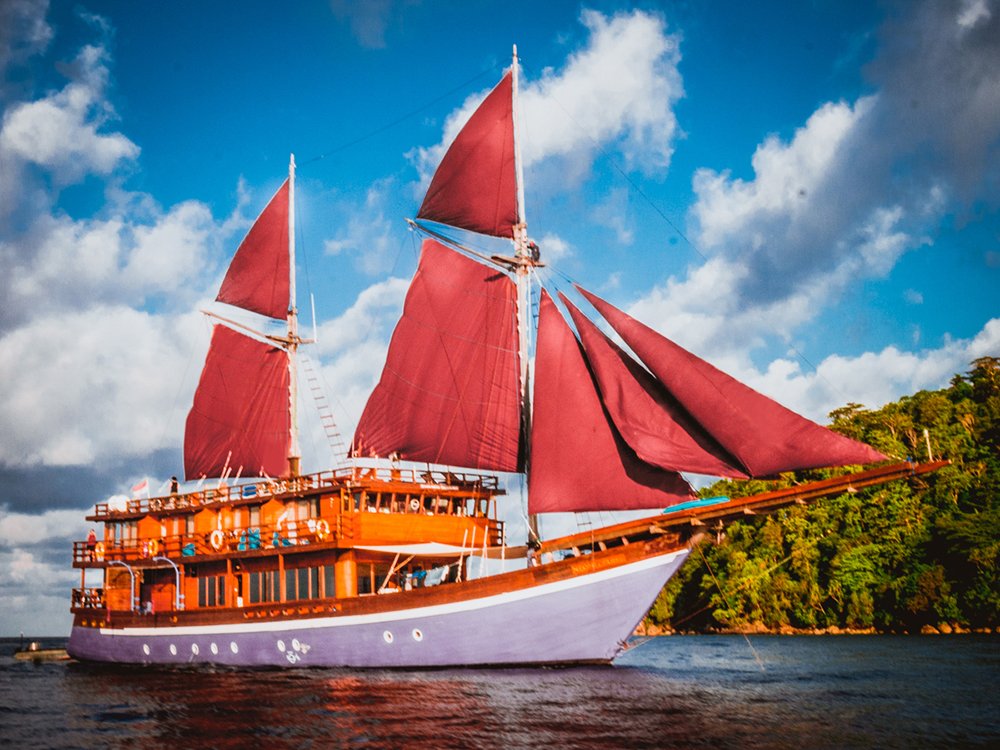Diving in Komodo National Park is a bucket-list adventure, and for good reason. This Indonesian National Park offers some of the most exhilarating underwater experiences in the world—kaleidoscopic reefs, sweeping currents, and a cast of marine life that includes everything from manta rays to tiny nudibranchs. A liveaboard trip is arguably the best way to experience Komodo at its best, but before you pack your dive gear and hop on, here’s what you need to know to make the most of your trip.
A Wild Ride in the Best Way
Komodo is like an underwater amusement park. The currents here are legendary—sometimes playful, sometimes sporty. If you love drift diving, you’re in for a treat. Sites like Batu Bolong and The Cauldron serve up fast-moving water that sweeps you past bustling coral gardens and hunting reef sharks. Some dives will have you posted on a rock to take in the show, while others will feel like an safari jeep ride. The currents are what bring in the nutrients needed to support one of the most biodiverse ecosystems in the world, and what make the diving in Komodo the world-class joy ride that it is.
That being said, this isn’t the place for a refresher course; make sure to take one before embarking on your trip if you haven’t dived in a while. A good level of comfort and competency in the water (and a little experience in unpredictable conditions) will make your dives more enjoyable. If you’re new to currents, a trusted dive operator will ease you in and teach you proper techniques before entering the water. Check out my blog on diving in currents for some tips and recommendations to get you started.
This photo shows a good example of the abundant diversity inhabiting the reefs of Komodo, with a giant trevally patrolling a reefscape full of snappers, surgeonfish and wrasse.
The Marine Life: Big, Small & Everything in Between
Sitting squarely in the Coral Triangle, Komodo’s biodiversity is off the charts. Schools of fusiliers and sweetlips swirl over vibrant reef, cuttlefish pulse with changing colors, and nudibranchs abound in mazes of hard and soft coral. On the megafauna side, you can hope to see reef sharks, tuna, and of course, the iconic manta rays that gracefully glide through the water at sites like Manta Point and Mawan.
Night dives here are also next-level and a macro-lovers dream. Bobtail squid, Spanish dancers, and bizarre crustaceans come out to play, making the reef feel like an alien planet.
One of my must-haves for a trip like this is my GoPro HERO 13. Although I love carrying a full-size camera rig, the action and water movement in Komodo can make a large set-up feel ungainly. The GoPro is small, easy to operate and delivers outstanding underwater image quality.
Komodo National Park: Underwater Wonder + Stunning Landscapes
Komodo is one of Indonesia’s premier National Parks, and includes the vast underwater reefs of Komodo, Rinca and Padar Islands. This archipelago sits atop a plateau which floods and drains with the tides. These tidal sweeps rinse and refresh the reefs with nutrients twice a day, which is the reason for the jaw-dropping diversity and abundance of coral species. These unending reefs are home to an equally mind-boggling array of vertebrate fish species.
Above the water, Komodo National Park boasts gorgeous tropical island landscapes. Explore a pink beach, winding island trails and the famous dragons. These reptiles, the largest land-dwelling lizards in the world are a spectacle all on their own. Many liveaboard excursions like my Komodo Dive Expedition include a visit to the Komodo dragon preserve. Just remember to listen to your guide—these prehistoric creatures may look sluggish, but they can move fast when they want to.
Neomi is a classic example of hand-built, wooden Phinisi, the traditional world-acclaimed Indonesian vessel. During my Komodo Dive Expedition, guests spend 6 days aboard the Neomi exploring the northern and central parts of the archipelago.
The Logistics
Labuan Bajo, the gateway to Komodo, is a lively little town with plenty of restaurants, dive shops, and a steady stream of backpackers and divers passing through. Accommodations range from budget hostels to high-end resorts, and there’s no shortage of places to relax before and after your liveaboard. Labuan Bajo has it’s own airport (airport code LBJ) and is accessible from many other hubs in Indonesia, as well as multiple international locations like Singapore, so travel to and from is simple.
When travelling to Komodo from the US, you’ll cross the international date line, which can be a bit confusing when you’re planning. Basically, think of losing a day when travelling west from the US, and gaining a day when travelling east to the US. For example, if you leave the US on a Wednesday at noon, and have 24 hours of travel, you’ll arrive on Friday at noon, not Thursday. And in travelling back to the US, if you leave on Wednesday at noon with 24 hours of travel, you’ll arrive on Wednesday at noon (a bit mind-boggling, right?!).
Although most flights into and out of Labuan Bajo are on full size commerical jets, it’s not a bad idea to pack lightly. I try to limit myself to a carry-on and personal item so that I don’t have to worry about a checked bag getting lost along the way.
Final Thoughts
A dive trip to Komodo is a mix of awe and adrenaline. It’s a place where every dive feels like an adventure, where the underwater world is as wild as the landscapes above. Go with an open mind, a sense of adventure, and a respect for the currents, and you’ll have an experience you won’t forget.
Click below to see the trip I have lined up there later in 2025.


